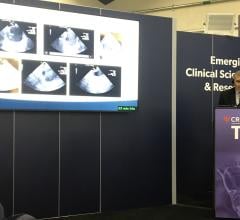
October 25, 2023 — Data from the REAL-PE study was presented today at Transcatheter Cardiovascular Therapeutics(TCT), the annual scientific symposium of the Cardiovascular Research Foundation, demonstrating that patients treated for pulmonary embolism (PE) with the Boston Scientific EKOS Endovascular System (EKOS) had lower rates of adverse events, including statistically significant lower rates of major bleeding, within seven days following their procedure compared to the Inari FlowTriever System. The analysis is the largest comparative study to use near real-time health system-based electronic health record (EHR) data to understand clinical practices and outcomes related to PE.
Each year, approximately 350,000 patients in the United States are affected by PE, a blood clot causing a blockage in one or more pulmonary arteries in the lungs and a leading cause of in-hospital death in the U.S. i,ii While treatment for PE has historically included anticoagulant medication, the use of new interventional therapies, such as the EKOS system, is increasing.iii The EKOS system uses a combination of ultrasound energy and a low thrombolytic drug dose to restore blood flow in patients with PE and other occlusions in the peripheral vasculature.
The REAL-PE study reviewed data from Truveta, a data and analytics company that provides EHR data from more than 30 U.S. health systems and 100 million patients, including lab values, co-morbidities, images, demographics and clinical outcomes, as well information about the performance of specific medical devices. In the REAL-PE analysis, 2,259 patients who experienced PE and received interventional treatment with either the EKOS system or the FlowTriever system between 2009 and 2023 were identified, and safety events associated with both devices were compared.
"In the past decade, there have been a number of advances in interventional therapies for the treatment of PE, but gaps in clinical evidence still exist when it comes to determining the optimal modality for each patient's unique needs," said Peter Monteleone, MD, FACC, FSCAI, an interventional cardiologist with Ascension and principal investigator of the REAL-PE study. "The REAL-PE study provides comprehensive data and unprecedented insight into the real-world performance of specific interventional devices, which can help physicians make more informed clinical decisions."
Major bleeding events in the REAL-PE study were based on definitions derived from established clinical criteria and guidelines, with statistically significant lower rates within seven days of the procedure consistently found in the cohort of patients treated with the EKOS system:
- A rate of 12.4% for patients treated with the EKOS system vs. 17.3% for those treated with the FlowTriever system (p=0.0018), using the International Society on Thrombosis and Haemostasis (ISTH) definition, and;iv
- A rate of 11.8% for patients treated with the EKOS system vs. 15.4% for those treated with the FlowTriever system (p=0.0190), using the Bleeding Academic Research Consortium type 3b (BARC3b) definition.v
Medical coding data in the analysis also demonstrated that intracerebral hemorrhage within seven days following the procedure occurred statistically significant less frequently among patients treated with the EKOS system (0.3% vs.1.3%, p=0.005). All other studied safety events also trended in favor of the EKOS system, including in-hospital mortality (2.6% vs. 3.7%) and all-cause 30-day readmission rates (5.1% vs. 5.4%). Median lengths of hospital stay were comparable at 3.6 days for both groups.
"Electronic health record data of this scale provides in-depth information about larger, more diverse patient populations, while also accounting for multiple variables including complex medical histories or co-morbidities that often exclude patients from clinical trials," said Michael R. Jaff, D.O., chief medical officer and vice president, Clinical Affairs, Technology and Innovation, Peripheral Interventions, Boston Scientific. "While data from clinical trials and registries will always play an important role in healthcare, access to the breadth of data such as that used in the REAL-PE study has the potential to better inform and accelerate clinical decision-making and, ultimately, improve patient care."
To date, the EKOS system has been used to treat more than 100,000 patients with PE globally, and the next-generation EKOS+ Endovascular System received U.S. Food and Drug Administration 510(k) clearance in 2022.
For more information: www.bostonscientific.com
Find more TCT23 conference coverage here
References:
i Centers for Disease Control and Prevention (CDC). Venous thromboembolism in adult hospitalizations - United States, 2007-2009. MMWR Morb Mortal Wkly Rep. 2012;61(22):401-404
ii Sedhom R, Megaly M, Elbadawi A, et al. Contemporary National Trends and Outcomes of Pulmonary Embolism in the United States. Am J Cardiol. 2022;176:132-138. doi:10.1016/j.amjcard.2022.03.060.
iii Giri J, Sista AK, Weinberg I, Kearon C, Kumbhani DJ, Desai ND, Piazza G, Gladwin MT, Chatterjee S, Kobayashi T, Kabrhel C, Barnes GD. Interventional Therapies for Acute Pulmonary Embolism: Current Status and Principles for the Development of Novel Evidence: A Scientific Statement From the American Heart Association. Circulation. 2019;140:e774-801.
iv Definition based on criteria from the International Society on Thrombosis and Haemostasis: Major bleeding diagnosis or a hemoglobin decrease ≥2 mg/dL and transfusion.
v Definition based on criteria from the Bleeding Academic Research Consortium: Major bleeding diagnosis or a hemoglobin decrease ≥5 mg/dL.


 November 09, 2023
November 09, 2023 








